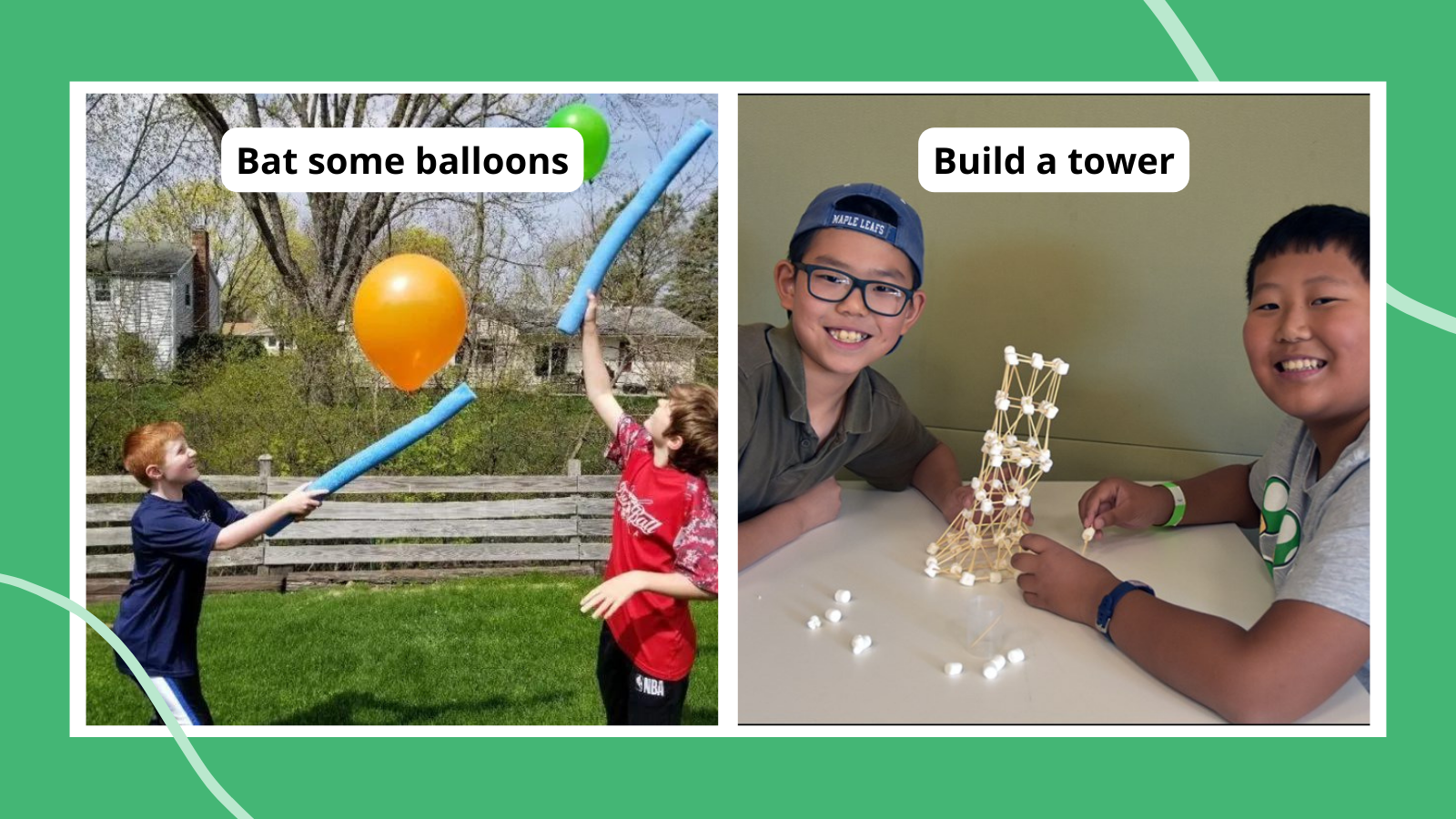Looking for great ways to help students learn to work together, listen carefully, communicate clearly, and think creatively? Try some of these awesome team-building activities for kids. They’re a super way to give your students the chance to get to know one another, build trust as a community, and, best of all, have fun!
1. Seeing Spots
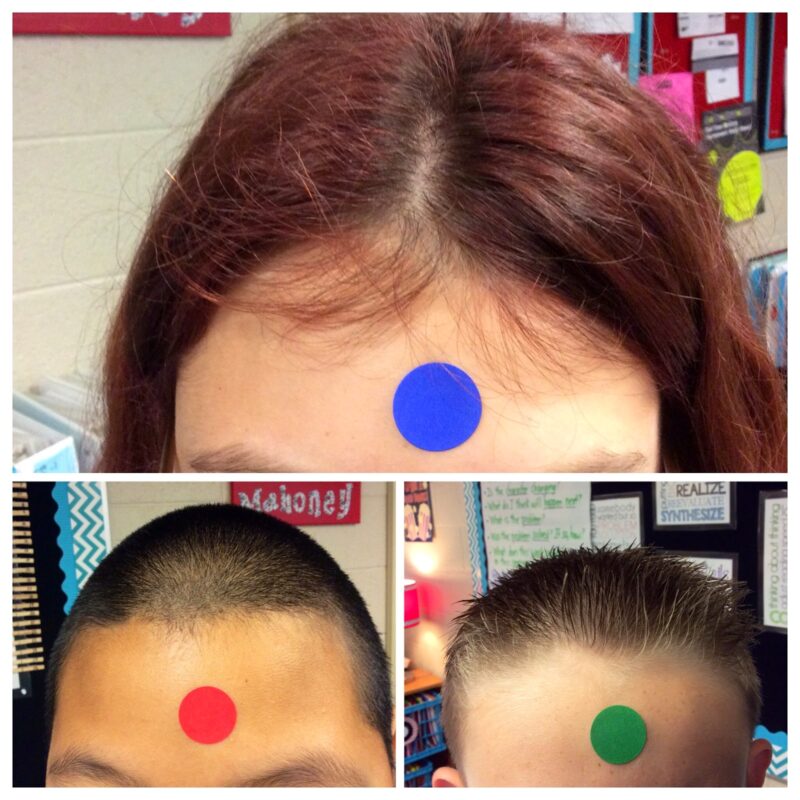
The Teacher Dish: Brain Break Dots via theteacherdish.blogspot.com
For this activity, you’ll place a colored sticker dot (blue, red, green, or yellow) on each student’s forehead without them knowing what color it is. When the game begins, each “team” of students (with the same color) must find each other—without speaking. This is a wonderful team-building activity because it encourages non-verbal communication and cooperation.
2. Elbow Pass
Looking for team-building activities for kindergarten kids? This silly activity helps them make new friends and learn to work together. Not only do they get to work on hand-eye coordination, they are looking each other in the eye and having a laugh together.
3. Common Thread

Fun 365/Team-Building Banner via fun365.orientaltrading.com
Divide students into groups of four and have them sit together in these small groups. Give each group five minutes to chat among themselves and find something they all have in common. It could be that they all play soccer, or pizza is their favorite dinner, or they each have a kitten. Whatever the common thread, the conversation will help them get to know one another better. Check in with the groups after five minutes to see if they need more time. After each group has come up with their common element, have them work together to create a flag that represents it.
4. Fingertip Hula-Hoop
There are quite a few team-building activities for kids that use Hula-Hoops. In this game, your students stand in a circle and raise their arms with only their index fingers extended. Place a Hula-Hoop so that it rests on the tips of the children’s fingers. Tell the students they must maintain a fingertip on the Hula-Hoop at all times, but they are not allowed to hook their finger around it or otherwise hold the hoop; the hoop must simply rest on the tips of their fingers. The challenge is for the children to lower the hoop to the ground without dropping it. To make this more challenging, you can place communication constraints on the children—no talking or limited talking, for example. Watch the video for a demonstration.
5. Four-Way Tug-of-War
This classic outdoor activity is double the fun of the traditional tug-of-war. Tie two long jump ropes together at their center points, creating an X shape. Tie a bandanna around the center point. Next, use cones to form a circle that fits around the X. Form four equal teams, and have each team stand at one of the four ends of the ropes. At your signal, each team begins pulling. The objective is to be the first team to pull the others in their direction far enough for the bandanna to cross to the outside of the circle of cones. Students who feel nervous about participating can serve as referees who make sure everyone is safe.
6. Hot Seat
This fun game is a lot like the game show Password. Split your class into two teams and have them sit together in teams facing the whiteboard or chalkboard. Then take an empty chair—one for each team—and put it at the front of the class, facing the team members. These chairs are the “hot seats.” Choose one representative from each team to come up and sit in the “hot seat,” facing their teammates with their back to the board.
Flash images one at a time on the screen behind the people in the hot seat. Taking turns, each team will offer one clue to their representative. If they guess the image correctly, their team gets one point. If not, it’s the other team’s turn to help their representative. Continue until one of the representatives gets the image correct. Then switch out students in the hot seat and continue.
7. Classification

Inspiration Laboratories/Classification Practice via inspirationlaboratories.com
For this activity, prepare a tray with 20 unrelated items—for instance, a spool of thread, an eraser, a juice box, etc. Alternatively, create a document with 20 images of items to put up on the screen. Divide your class into even groups. Set a timer and have each group divide the 20 items into four categories that make sense to them. For example, they may put an earring, a glove, a headset, a sock, and a smile into the category “things you wear.” Have groups work quietly so that their ideas are kept secret. When each group is finished, give each one time to present their categories and their rationale behind each category.
8. Yes, No, Stand Up
The version of the game above is designed specifically to help English-language learners, but it can also be used as a good “get to know you” game for younger kids. Prepare a list of yes or no questions to ask your students. For example, do you like chocolate? Is your favorite color blue? If their answer is yes, the student stands up. If their answer is no, they sit down. Pause between questions to give students time to look around and find students they have answers in common with.
9. Balloon Battle
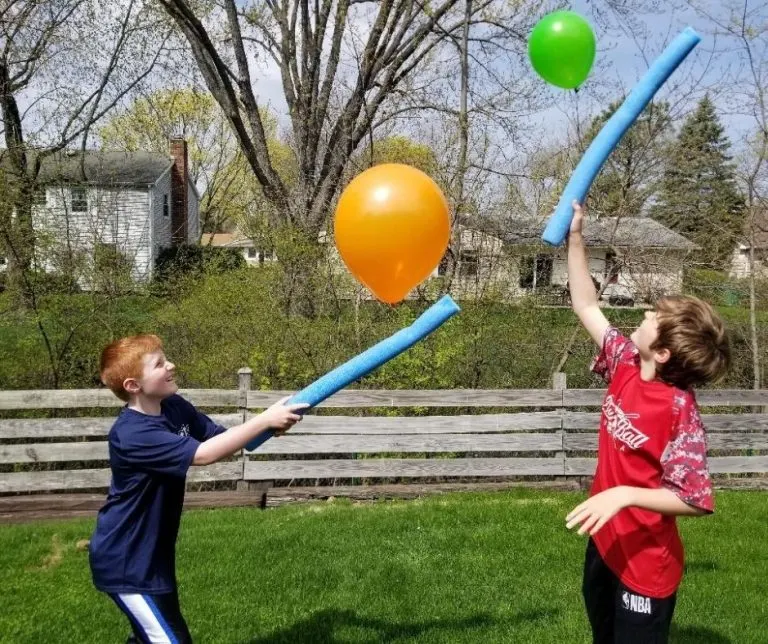
Happy Mom Hacks/Balloon Games via happymomhacks.com
This fun game teams students up as they try to bat a balloon over each other’s goal line. Divide students into two teams. Each team will have five players on the field at one time. Periodically blow a whistle to have students substitute in so that everyone gets a chance to play. The first team to score 10 points wins. For more fun balloon games check out Happy Mom Hacks.
10. Move On, Look Back
This hopping game will crack your students up. Start with students in a circle with their hands on the shoulders of the person in front of them. When you say “Move on,” students will take one hop forward together. When you say “Look back,” students will take one hop backward together. And when you say “Forever alone” (or any other phrase you’d like, such as “180” or “Turn around”), students will turn 180 degrees and place their hands on the shoulder of the person who was behind them.
11. Birthday Line-Up
Did you know there are team-building activities for kids that can help teach students how to line up? It may take 5 to 10 minutes, depending on the age of your students, so plan accordingly. The objective is to have students line up in order of their birthdays—January 1 through December 31. To do this, they will need to know the order in which the months fall as well as their own birthday. They will also need to talk with one another in order to figure out who goes in front of whom. To make it super challenging, tell them they must do it without speaking at all, only using hand signals. Other ways to line up include by height, alphabetically, or by foot size.
12. The Perfect Square
This activity requires strong verbal communication and cooperation. All you need is a long rope with the ends tied together and something to serve as blindfolds for students, such as bandannas or fabric strips. Have students stand in a circle holding the rope in front of them. Signal them to put their blindfolds on and set the rope on the ground in front of them. Ask students to turn and walk a short distance away from the circle. Assign a partner to any students who may need help. Finally, have everyone come back to the rope and try to form a perfect square with their blindfolds on. Set a time limit to make it more challenging.
13. Rock, Paper, Scissors Tag
If you have a large space for kids to do team-building activities, try this one. Divide students into two teams. Before you begin, stake out the boundaries and position a home base at either end for each team. For each round, each team must confer and decide whether they will be rock, paper, or scissors. Have the two teams line up facing each other, and on your signal, have all players flash Rock, Paper, Scissors, Shoot! The kids on the losing team must run back to their base before they are tagged by one of the kids on the winning team.
14. Flip-the-Tarp Challenge
Looking for creative-thinking team-building games and activities for kids? Divide students into two teams. One team will do the challenge first while the other team watches, then they will switch places. Have all members of the team stand on a flat bedsheet, tarp, or blanket (kids should fill up all but about a quarter of the space). Challenge the team to flip over the sheet/tarp so that they are standing on the other side of the sheet/tarp without stepping off or touching the ground.
15. “Get To Know You” Balloons

Beth Smith/ABC Scavenger Hunt via darlingtonschool.org
Give each student an empty balloon and a slip of paper. Ask them to write a get-to-know-you question on their paper, such as How many brothers and sisters do you have? Do you have any pets? What’s one fun thing you did this summer? Next, have them put their question inside the balloon, blow it up, and tie the end.
When everyone is ready, have them gather on the rug and, on your signal, toss their balloon up in the air. Give them a couple of minutes to bat the balloons around, then call stop. Have each student grab one balloon and come sit in a circle. Go around the circle and, one at a time, have students pop their balloon, read the question inside, and answer the question. This is one of those team-building activities for kids that they will always remember.
And to help your students remember each others’ names, try these 30 Fun Name Games To Try With Your New Class.
16. Hot and Cold
Form groups of three to five students. One person from each group (the finder) steps out of the classroom. The rest of the group picks an object (for instance, the pencil sharpener) in the classroom for the finder to find. When the finder comes back in, they begin walking around the classroom in search of the object. The others guide the finder by saying “hot” or “cold” to lead them in the right direction. If the finder is far away from the object, the group will say “cold.” When the finder gets close, the group will say “hot” until the finder picks the correct object. Variation: Instead of saying “hot” and “cold,” have students applaud softly for cold and applaud vigorously for hot.
17. Marshmallow-and-Toothpick Challenge
Divide students into groups of equal numbers. Pass out an equal number of marshmallows and wooden toothpicks to each group. Challenge the groups to create the tallest, largest, or most creative structure in a set amount of time, each member taking turns doing the actual building. Afterward, have each group describe what they made.
18. Art Reproduction Puzzle

The Teaching Distillery/Puzzles via theteachingdistillery.com
Divide students into groups of six or eight (or larger if you want to make the task more difficult). Provide each team with an image and blank pieces of white card stock, one per team member. First, each team must cut up the image into the same number of pieces as there are group members. Then, each player will take one of the pieces of the image and reproduce it onto their blank piece of card stock with pencils, colored pencils, or markers. (If the team cuts the image into irregularly shaped pieces, each team member must then cut their blank paper into the same shape.) When every team has created the pieces of their puzzle, they will switch pieces with another team. The team will work together to solve the puzzle.
19. Hula-Hoop Pass
This activity helps kids work on listening, coordinating, and strategizing skills. It works best with smaller students. Have your students stand in a big circle. Place a Hula-Hoop on one student’s arm and have them join hands with the student next to them. Ask all the other students to join hands to close up the circle. The objective of the game is to pass the Hula-Hoop all the way around the circle without unclasping hands. Students will have to figure out how to maneuver their bodies all the way through the hoop to pass it on.
20. Bumpity-ump-bump-bump
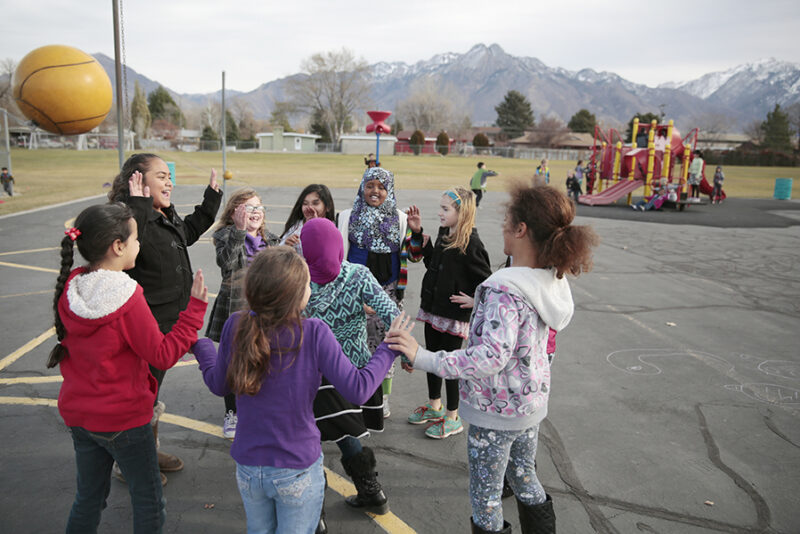
Playworks/Bumpity Bump Bump via playworks.org
This is a fun name game that requires quick thinking! Students stand in a large circle. One student comes to the middle. That student walks around the inside of the circle, stops in front of one person, and gives them a direction. There are four choices: Left = say the name of the person to the left; right = say the name of the person on the right; it = say the name of the person who is it; or self = say one’s own name. After you give the student the direction, the designated person says “bumpity-ump-bump-bump!” out loud. The student who was given the direction races to say the name of the correct person before the student finishes the phrase. If they can’t, they’re the next person on the inside of the circle.
21. Snakes
In this challenging trust-building activity, blindfolded students line up with their hands on each others’ shoulders. A person without a blindfold takes the end position. The object of the activity is for the sighted person to guide the non-sighted students without verbal communication to collect various soft objects scattered on the floor. Once the lead person finds an object, they must deposit it in a bucket. Extra challenge: Students must keep their hands on each others’ shoulders at all times.
22. No-Hands Cup-Stacking Challenge
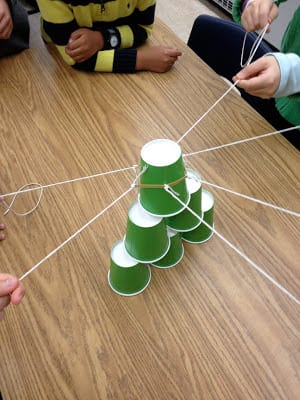
Nick Cornwell/Stacking Cup Challenge via nickcornwell.weebly.com
If you’re looking for hands-on team-building games and activities that work for groups of kids, try this challenge. It’s an exercise in patience and perseverance, not to mention a total blast! Decide how many students you want in each group and tie that number of strings to a single rubber band, making one for each group. Each person in the group holds on to one of the strings attached to the rubber band, and, as a group, they use this device to pick up the cups (by expanding and contracting the rubber band) and place them on top of each other in order to build a pyramid. See detailed instructions here.
23. Mini Cup-Stacking Challenge
And for younger students, this simplified version of the game allows kids to partner up one-on-one. Using just a few pipe cleaners and a rubber band, each student can take a hold and work together to create a stack.
24. Body Parts

Karl Bastian/Head, Shoulders, Knees, Cup via kidologist.com
Students face off head-to-head in a squat position with a plastic cup on the ground between them. The leader calls out body parts and the players have to move their hands to that spot—head, knees, toes, eyes, nose, etc. But when they say “Cup!” the pair each tries to grab the cup. If they grab it, they remain in the game. The other player is “out” for the rest of the round.
Also, if a student touches the cup when “Cup!” was not called, they are immediately out! So they need to listen carefully as the leader attempts to trick them into lunging toward to the cup.
25. Human Alphabet

Nadine Silverthornes/Alphabet Game via todaysparent.com
If you have a large open space for your team-building games and activities, try this idea. Have students spread out and guide them through a few rounds of forming letters with their bodies. For instance, “Use your body to make a T. … Now make an O!”
Next, call out a simple short word, such as “so” or “dog.” Students will have to team up to form the word, with each student using their body to form one of the letters. Start with two-letter words, then three, then four. If students want more of a challenge, come up with a phrase that will take the whole class to complete.
26. Caterpillar
Divide students into groups of four. Lay out four Hula-Hoops per group and have one student stand in the center of each one to form teams of “caterpillars.” Line all of the teams up at the end of a field or large open space. Set out four or five objects in front of the lines, such as cones, foam blocks, or balls.
The goal of the game is to collect as many objects as possible by moving the caterpillar forward. To move forward, the last player in line steps into the hoop with the player in front of them, picks up their empty hoop, and passes it overhead to the front of the line. The front player then places the hoop on the ground in front of them and steps into it. Every player then shifts forward, moving the caterpillar. Only the front player may pick up objects, but it is the team’s job to carry the collected objects throughout the game. The game ends when there are no more objects on the ground.
27. Shrinking Vessel
For this activity, you will need a few jump ropes. Divide students into groups of six or eight. Have each group make a circle with their jump rope (their “lifeboat”) on the ground so that the ends are touching. Now have all the members of each group get into their lifeboat. This should be easy the first time. Then have all players get out and reduce the size of their circle by one foot. Again, all players need to get into the boat. Repeat this process, making the lifeboat smaller and smaller while you watch your students come up with creative solutions for making sure that everyone fits safely inside their boat.
28. Pretzel, Unpretzel

Susan Box Mann/The Human Knot Game via icebreakerideas.com
This is one of the all-time favorite team-building activities for kids. Divide your class in half and have each group choose one pretzel maker and two unpretzelers. Direct the unpretzelers to turn their backs. Have the rest of the students in each group form a circle and hold hands. Now, have the pretzel maker direct the students (with words only) to twist around, step over, and duck under each others’ arms to form a human pretzel. Once they are sufficiently twisted, call the unpretzelers over and have them try to direct the students (with words only) in order to untangle them. Students cannot drop their hands at any time. The first team that successfully unpretzels their group wins.
29. Zip, Zap, Boing!
This super-lively circle game involves three actions—zip, zap, and boing. Zip directs play in one direction around the circle. Boing reverses the direction of play. And zap passes play to the opposite side of the circle. See the video above for a full demonstration. A couple of rules: Boing cannot be performed when someone passes the signal using zap. And zap cannot be passed to the person standing right next to you.
30. Spiderweb
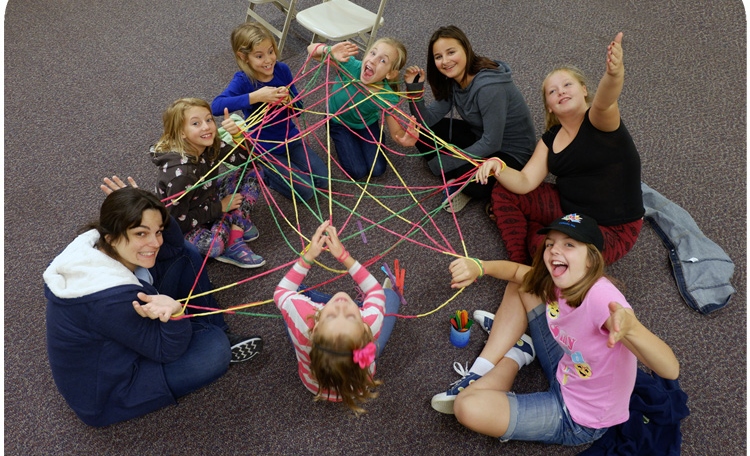
Heather Lynne/Would You Rather Web at raisingmemories.com
This team-building game will teach your students that even though they may be different in many ways, they are still connected to one another. Gather in a circle, standing or sitting. The game begins when the first person, holding a large ball of twine, tells the group a funny or embarrassing story about themselves.
Once they finish, they hold on to the end of the twine and throw the ball to someone else in the circle. Play continues until the twine has been passed to each person. The end result will produce a “spiderweb” out of the twine, connecting each student to all of the others.
31. Team Tic-Tac-Toe
This fun and active version of the old-fashioned game gets kids revved up about working as a team. Hula-Hoops are placed in the shape of a tic-tac-toe frame. Then students divide into teams and the race begins! One student from each team runs to the frame and drops a bean bag in a spot. They return and tag the next runner, who does the same thing. Play continues until one team achieves a tic-tac-toe!
32. Newspaper Fashion Show

Andrea and Rachel/Newspaper Fashion via mommylessons101.com
This is a great way to incorporate upcycling into your team-building games and activities. Divide students into groups of five or six, then give them a stack of newspapers, tape, and scissors. Set a timer and ask them to create the most fashionable outfit using only the supplies given. When time is up, have each group designate a model for the outfit, and have the group share information about the outfit. Once everyone shares, put on some rocking music and have a mini fashion show.
33. Back-to-Back Drawing
https://youtu.be/EqsL64uk1Q4
Need team-building games and activities that build communication skills? Ask students to pair up and sit back-to-back with their partner. Give one student a blank piece of paper and a pen or a marker. Give the other student a piece of paper with a simple drawing on it. The kid who receives the illustration will verbally describe the drawing to their partner. The other kid must draw the illustration by listening to the verbal instructions alone.
34. Changing Tableau
Ask for five or six volunteers to come up to the front of the class. Divide the rest of the students into two teams and have them sit together. Have the students up front arrange themselves into a tableau. Give the two teams a short time to observe the tableau, trying to memorize their physical arrangement.
After a couple of minutes, ask every person on both teams to face away from the team up front. The tableau team will decide on one thing to change about the tableau. When they are rearranged, the teams can turn around and try to figure out what changed. The first team to spot the difference gets a point. Continue play until one team receives 10 points.
35. Straw Challenge
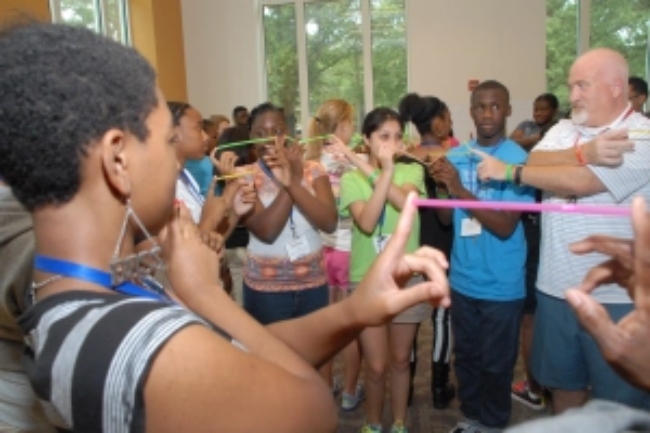
Georgia Teen Institute/Straw Challenge via https://guidegti.wordpress.com
If you’re looking for team-building games and activities for kids that require coordination and cooperation, try this one. Have your students form a large circle and give each one a plastic straw. The objective of the challenge is to balance each straw between one person’s right pointer finger with the left pointer finger of the person next to them. Try making some movements such as rotating the circle to the left or right, raising one foot, etc. The challenge is to keep the connection of straws intact.
36. Group Juggle
Have students circle up and make sure you have a supply of small plastic balls at the ready. Start by tossing one ball from person to person in the circle. After a minute, add in another ball. Instruct students to mindfully toss the ball, avoiding a collision. After another minute, add in another ball. Continue adding balls each minute to see how many balls your students can successfully juggle.
37. Hula-Hoop Ring Toss
Team members take turns tossing a Hula-Hoop over colored cones. Each color has a different point value. This game also incorporates math practice when adding your team’s score.
38. Great Chain Race

Jennifer/Paper Chain STEM Challenge via themathchick.net
For this team-building activity, students split up into groups of three or four. Each group gets one sheet of paper (a different color for each group), one pair of scissors, and one glue stick. The teams then cut their paper to make a paper chain that’s as long as possible—they might choose to make many skinny rings or cut up small rings to get as many rings from their paper as possible. In the end, lay out the paper chains the kids created and see whose is the longest.
39. Team Pen
Working together, students try to create a drawing. Attach strings to a marker, however many you’d like. Have students each take one end and gather around a table. Together, they will need to communicate in order to manipulate the pen and draw the required image.
40. Knee Relay
This raucous activity will have your students rolling on the floor with laughter. Using only their knees, players must take turns picking up oranges one at a time from the ground and transfer them to a hoop across the room. The team to transfer the most oranges in 60 seconds wins. Plus, you’ll have a juicy snack for everyone when you’re done.
41. Human Caterpillar Activity
Students will work together to move a circle made of newspapers across the room. Before you begin, use strong tape to connect the sections of newspaper into a loop. To begin, students will step inside and move their feet and hands to help move the loop in the direction of the finish line, as shown in the video. The challenge is keeping pace with the students in front of them. The first team that is able to navigate their caterpillar to the finish line first is the winner.
42. Blind Minefield
Looking for obstacle course team-building activities for kids? This fun and challenging activity requires communication, listening skills, and trust. Students will navigate through an obstacle course while blindfolded with the help of a partner who will call out directions. If the blindfolded student touches any of the objects in the minefield, their turn is over and another pair gives it a try. The team with the most players to make it through without touching any hazards wins.
43. Paper Tower
Using creative problem-solving skills, each team of students must build the tallest tower possible with 20 sheets of plain computer paper. The tower must be stable enough to be measured. This activity is not only a great team-building activity, it’s a lot of fun!
Do you have favorite go-to team-building activities for kids? Come share in our WeAreTeachers HELPLINE group on Facebook!
For more great ideas, check out 45 of the Best Cooperative Games To Promote Camaraderie and Healthy Competition.
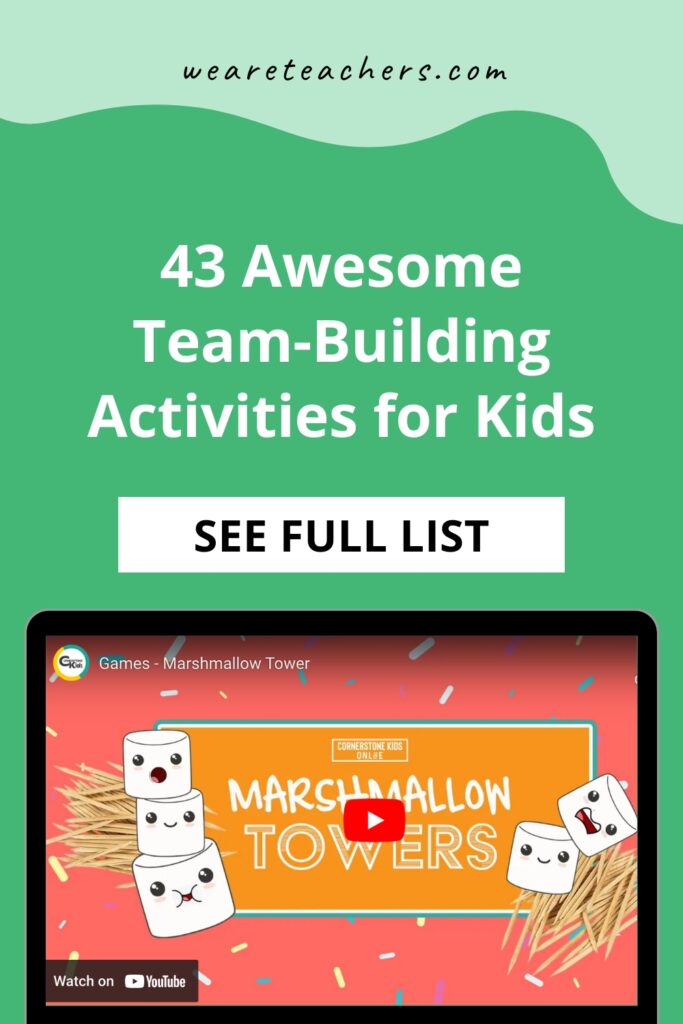
WeAreTeachers
